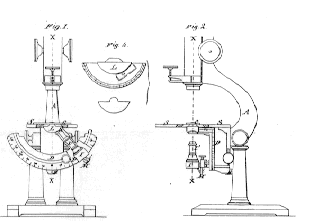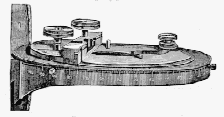| Table of Contents | Subscription info |

| Table of Contents | Subscription info |


Robert B. Tolles was born in the early 1820's, in Litchfield County, Connecticut, to Elisha and Harriet Tolles. As a youth, he worked on his grandfather's farm and attended public school. He received no further formal education. In 1843, after his mother's death, Tolles visited an uncle near Rochester, then started for New York, stopping off in Canastota, where he met Charles A. Spencer. Legend has it that Tolles was so taken with Spencer's work that he decided on the spot to make microscope building his life's work. He arranged to apprentice with Spencer and stayed 15 years, until 1858.
Tolles and Spencer corrected spherical aberration from the cover glass with a ring to move the center elements of immersion objectives, without moving the front element. Tolles patented his solid ocular in 1855 (U.S. Patent No. 13603). The idea of the solid ocular was to eliminate the internal lens surfaces. Spencer also shares credit for developing the solid ocular, and, subsequently produced many such eyepieces. Tolles left Spencer's employ to establish his own business in Canastota in 1858.
 In 1866, He developed a vertical illuminator using a totally reflecting prism just above the front lens of the objective. He referred to his invention as an interior illuminator. Also in 1866, Tolles patented a binocular adapter for monocular microscopes (U.S. Patent No. 56125). Behrens states in his 1885 book, The Microscope in Botany, "Not withstanding its excellent workmanship, good definition, fine stereoscopic effect, and ease of removal, this ocular never came into use, less perhaps, on account of its considerable cost, than because of the small, high power oculars and parallel tubes required in its construction." Several other sources highly praise the Tolles binocular eyepiece, but acknowledge that it was expensive. Tolles also made a high quality student microscope for many years.
In 1866, He developed a vertical illuminator using a totally reflecting prism just above the front lens of the objective. He referred to his invention as an interior illuminator. Also in 1866, Tolles patented a binocular adapter for monocular microscopes (U.S. Patent No. 56125). Behrens states in his 1885 book, The Microscope in Botany, "Not withstanding its excellent workmanship, good definition, fine stereoscopic effect, and ease of removal, this ocular never came into use, less perhaps, on account of its considerable cost, than because of the small, high power oculars and parallel tubes required in its construction." Several other sources highly praise the Tolles binocular eyepiece, but acknowledge that it was expensive. Tolles also made a high quality student microscope for many years.
In 1867, Charles Stodder and several other Boston businessmen offered Tolles a partnership if he would move his business to Boston. Tolles agreed, and moved to Boston to supervise Boston Optical Works. Early ads list the address at 66 Milk Street. After a fire at that location, the business was moved to the Rialto building at 131 Devonshire St, Boston. The partnership of Boston Optical Works dissolved in 1872, leaving Tolles the sole proprietor. Apparently, Tolles perfectionist approach resulted in too low a volume to turn a profit, so his partners withdrew, leaving him to muddle on, producing some of the world's best lenses in the process. Tolles had few assistants, doing most of the work himself.
Tolles is best known for producing objectives of very large aperture. He published the formula for these lenses in 1874 to demonstrate that his extremely wide apertures were real. His water, glycerine, and balsam immersion objectives were world renowned. Tolles 1/10" objective using Canada balsam as the immersion medium was a revolutionary step forward. Canada balsam has the same refractive index as glass, resulting in a homogeneous immersion system. Tolles 1/10 balsam lens had an aperture of 110 degrees. He designed an instrument for measuring the aperture of his objectives in 1873, described in an article "An Apparatus for obtaining the balsam angle of any objective" in Monthly Microscopical Journal, 1873, p212. His 1/75th objective first used for photomicrography by E. Cutter, is described in the American Journal of Science in 1879.
Although best known for his microscopes and objectives, Tolles also made small telescopes. A letter in the July, 1871 issue of American Journal of Science mentions a 5" Tolles Telescope of 35" focal length. His 1879 catalog lists an inch "Pedestrian's telescope", a 1 inch and a 2 inch "High School Telescope".
While Francis Wenham is credited with originating the duplex front, Tolles' early Duplex objectives were unexcelled. Tolles' claims of extremely wide apertures were bitterly contested by Wenham for years. He denied that Tolles had produced or could ever produce an objective of greater balsam angle than was equivalent to near 180 degrees measured in air. The Monthly Microscopical Journal carried this controversy in many issues during the 1870's. J.J. Woodward tested Tolles 1/10 by photographing both the 19th band of Norbert's test plate and the diatom, Amphipleura pellucida. Although Tolles did have his supporters, even within the Royal Microscopical Society, apparently, his nature led him to not waste a great deal of time writing to journals in defense of his work. Jacob Cox wrote a lengthy summary of the angular aperture debate shortly after Tolles death. It was published in the Proceedings of the American Society of Microscopists in 1884.
There are several other instances in the literature where Tolles is not credited for his inventions. In the May, 1880 issue of the American Journal of Microscopy, Wm. A. Rogers, of Harvard College, is claimed to be the inventor of the above mentioned interior illuminator. Rogers promptly responded to the journal, stating that Tolles was the inventor and quoting an article in the Annual of Scientific Discovery, 1866-7, p149. Earlier, a more persistent error credited H.L. Smith with the invention of Tolles unique binocular eyepiece arrangement. This error even found its way into Hogg's 7th ed. Of The Microscope and Carpenter's 4th ed. Smith wrote a long letter to the Monthly
Microscopical Journal in 1871, outlining the chain of events that must have led to this error, and giving Tolles full credit for the invention.

In 1877, Tolles applied for patents on his illuminating traverse lens, an unusual substage illuminator to provide oblique lighting up to 70 degrees for use with his wide aperture objectives (U.S. Patent No. 198782 and 198783). This device could also be used for measuring the aperture of objectives, and was adjustable for varying thickness of the slide.
He also developed a thin mechanical stage with surface mounted knobs and both x-y movement and rotation. This stage also was adapted for use with his traverse lens.

Tolles was 61 years old when he died Nov 17th, 1883. Dr. Blackham writes in his memoir of Tolles in the Proceedings of the American Society of Microscopists, 1884, "Robert B. Tolles best and most endearing memorials are in the beautiful lenses, the products of his brain and hand, that are now treasured by their fortunate owners".
 Charles X. Dalton, a long time workman for Tolles, continued making Tolles' stands after his death. An ad for Boston Optical Works ran as late as 1895, with a new location at 30 and 48 Hanover Street, Boston. While the ad is for "Charles X. Dalton, successor to the late R.B. Tolles" it features "Tolles objectives" and "Tolles celebrated achromatic triplets in silver cases". Twelve years after Tolles' death, his name must still
have been the main selling point for Boston Optical Works.
Charles X. Dalton, a long time workman for Tolles, continued making Tolles' stands after his death. An ad for Boston Optical Works ran as late as 1895, with a new location at 30 and 48 Hanover Street, Boston. While the ad is for "Charles X. Dalton, successor to the late R.B. Tolles" it features "Tolles objectives" and "Tolles celebrated achromatic triplets in silver cases". Twelve years after Tolles' death, his name must still
have been the main selling point for Boston Optical Works.
This large stand (photo at right), lacking the stage and optics, was found at the Brimfield flea market in 1989. It is signed "Dalton, Boston". This is the only stand of which I'm aware that is signed by Dalton. The Tolles influence is apparent.
| student microscope | Tolles objective |
|---|---|
| SMMA home page | other microscope makers |